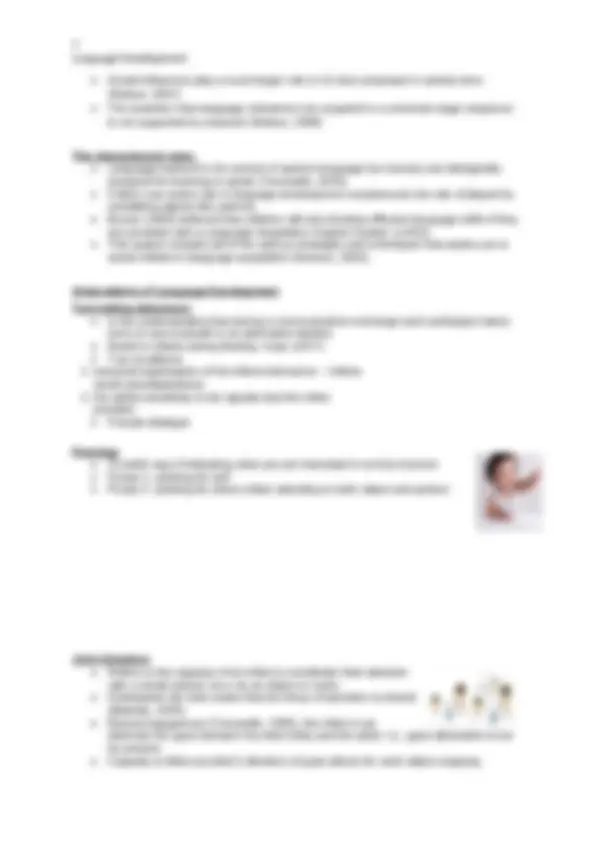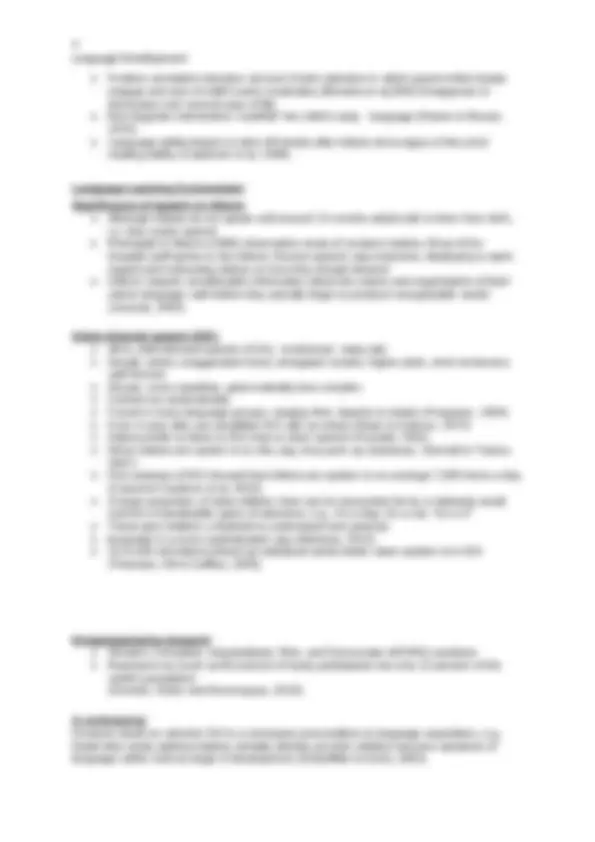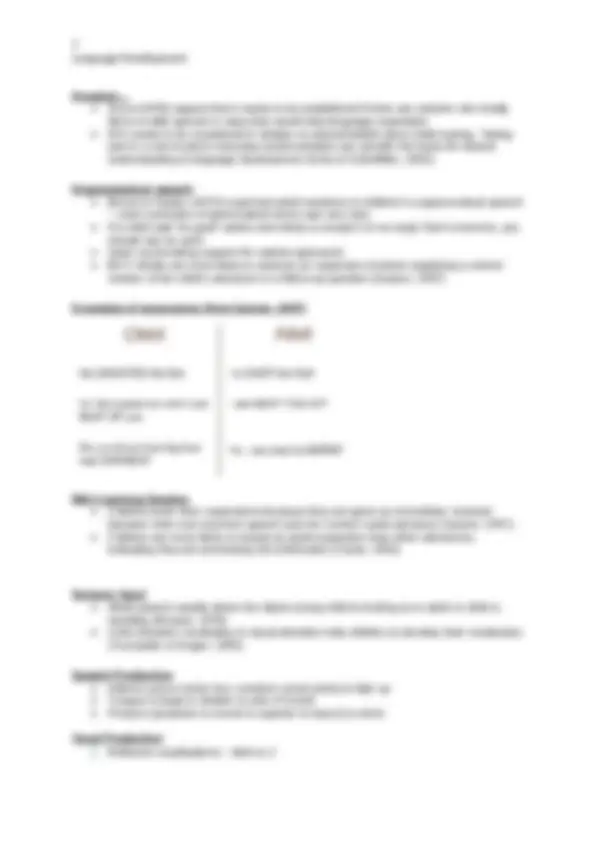





Study with the several resources on Docsity

Earn points by helping other students or get them with a premium plan


Prepare for your exams
Study with the several resources on Docsity

Earn points to download
Earn points by helping other students or get them with a premium plan
Community
Ask the community for help and clear up your study doubts
Discover the best universities in your country according to Docsity users
Free resources
Download our free guides on studying techniques, anxiety management strategies, and thesis advice from Docsity tutors
The theories of language development, focusing on the learning view, nativist view, and interactionist view. It also covers the components of language development, including semantics, syntax, pragmatics, and phonology. the claims and limitations of each theory, as well as the role of social influences and the language learning environment.
What you will learn
Typology: Lecture notes
1 / 6

This page cannot be seen from the preview
Don't miss anything!




The Development of Language Main focus: Theories of language development Antecedents of LD Language learning environment From first words to complex sentences Components of language Development There are four main areas of language competence the child must acquire
Grammatical rules as inherited capacity Language Acquisition Device (LAD) Children are born with an innate mental structure that incorporates the principles of language which enables them to identify grammatical rules in the speech they hear (Chomsky, 1968) Language is species specific therefore all languages of the same species must display universal features Common principles do underlie all human languages (Slobin, 1985, 1992) ~ Universal grammar: all languages contain nouns Children acquire language relatively quickly & learn it well (Pinker, 1994) Children even learn language with restricted input (Bickerton, 1983, 1990, 2008) – creole languages But what about children’s errors? Continuity hypothesis peripheral problems, e.g., identifying parts of speech or memory limitations account for errors when children overcome pp’s language advances (Clahsen, 1992) Maturation hypothesis initially children do not have access to all their inherited linguistic knowledge which becomes available as children get older (Felix, 1992) Critical Period Hypothesis (Lenneberg, 1967) Book – Biological Foundations of Language Optimal period for language acquisition when a child is sensitive to particular environmental stimulus – infancy to puberty During the CP a child may achieve the fluency of a native speaker in any language without special training but after puberty it is extremely difficult to learn a first language Explanation: period coincides with the brain lateralisation process (the specialisation of the dominant hemisphere of the brain language functions) Linguistic Deprivation ‘Forbidden experiment’ Extreme deprivation 1970 – 13 years 2 words ‘stopit’ ‘nomore’ (Rymer, 1993) Could acquire words but not grammar/syntax Processed language on right side of her brain (Curtiss, 1977) EEG - bundled sleep spindles General cognitive deficit? Problems: Acquisition of sign language – necessitates identifying linguistic structure in speech and in hand movements Neurophysiological plausibility – does the brain really possess a considerable amount of specific innate information that can be set in operation by hearing the speech of others?
Positive correlation between amount of joint attention in which parent infant dyads engage and size of child's early vocabulary (Morales et al,2000) Disappears or decreases over second year of life Non linguistic interactions ”scaffold” the child’s early language (Ratner & Bruner,
Language ability begins to take off shortly after infants show signs of this mind reading ability (Carpenter et al, 1998) Language Learning Environment Significance of speech to infants Although infants do not speak until around 12 months adults talk to them from birth, i.e. they evoke speech Rheingold & Adams (1980) observation study of newborn babies. Most of the hospital staff spoke to the infants. Nurses speech was extensive, displaying a warm regard and instructing infants on how they should behave! Infants ‘acquire considerable information about the nature and organisation of their native language well before they actually begin to produce recognisable words’ (Jusczyk, 2002) Infant directed speech (IDS) AKA, child directed speech (CDS), ‘motherese’, baby talk Simple words, exaggerated tones, elongated vowels, higher pitch, short sentences well formed. Slower, more repetitive, grammatically less complex. Carried out automatically Found in many language groups, ranging from Apache to Arabic (Ferguson, 1964) Even 4 year olds use simplified IDS with an infant (Shatz & Gelman, 1973) Infants prefer to listen to IDS than to other speech (Fernald, 1991) When babies are spoken to in this way, they perk up (Santesso, Schmidt & Trainor,
One analysis of IDS showed that infants are spoken to on average 7,000 times a day (Cameron-Faulkner et al, 2003) A large proportion of what children hear can be accounted for by a relatively small number of predictable types of utterance, e.g., it’s a dog, it’s a car, “it’s a X” These give children a foothold to understand and produce language in a more sophisticated way (Ibbotson, 2012) 10 month old infants picked up individual words better when spoken to in IDS (Thiessen, Hill & Saffran, 2005) Unrepresentative research Western, Educated, Industrialized, Rich, and Democratic (WEIRD) societies Represent as much as 80 percent of study participants but only 12 percent of the world’s population (Henrich, Heine and Norenzayan, 2010) A controversy However doubt on whether IDS is a necessary precondition to language acquisition, e.g. Kaluli tribe rarely address babies verbally directly yet their children become speakers of language within normal range of development (Schieffelin & Ochs, 1983)
However… Snow (1995) argued that it needs to be established if there are cultures who totally fail to modify speech in ways that would help language acquisition IDS needs to be considered in relation to cultural beliefs about child rearing. Taking part in a community's everyday social activities can provide the basis for shared understanding & language development (Ochs & Schieffelin, 1995) Ungrammatical speech Brown & Hanlon (1970) examined adult reactions to children’s ungrammatical speech ~ overt correction of grammatical errors was very rare. If a child said ‘he goed’ adults were likely to accept it & not reply ‘that’s incorrect, you should say he went’. (seen as providing support for nativist approach) BUT! Adults are more likely to produce an expansion involves supplying a correct version of the child’s utterance or a follow up question (Saxton, 1997) Examples of expansions (from Saxton, 1997) Mini Learning Session Children learn from expansions because they are given an immediate ‘contrast’ between their own incorrect speech and the ‘correct’ adult utterance (Saxton, 1997) Children are more likely to repeat an adult expansion than other utterances, indicating they are processing the information (Farrar, 1992) Sensory Input Adult speech usually about the object young child is looking at or adult or child is handling (Messer, 1978) Links between vocabulary & visual attention help children to develop their vocabulary (Tomasello & Kruger, 1992) Speech Production Infants Larynx (voice box, contains vocal cords) is high up Tongue is large in relation to size of mouth Pharynx (posterior to mouth & superior to larynx) is short Vocal Production